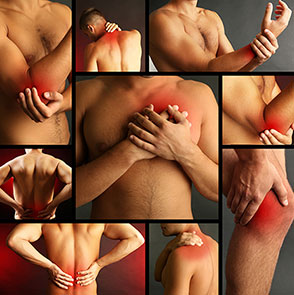Keep reading and find out more about the physiological differences between different tissue types and how they affect the following conditions:
MUSCLE TEARS
Skeletal muscles are formed by millions of fibres. Some of them are called red fibres as they have a great capillary density, large amount of myoglobin, many mitochondria and large amount of glycogen.
Muscle fibres are arranged in bundles. Endomysium is connective tissue which fills the gaps between the fibres. The bundles are surrounded by connective tissue called perimysium. Arteries and capillaries enter the muscle at its ends and spread into the perimysium forming a perfect circuit which allows blood flow to enter into the muscle cells.
These fibres are designed to stretch and contract in order to allow a specific Range Of Motion. Tears will occur if we go beyond this range causing muscle damage.
Unlike tendons and ligaments muscles have certain characteristics such as excitability, contractibility, extensibility and elasticity, great good blood supply and the existence of millions of fibres within each muscle. All this means not only that the probability of muscle injury is lower but skeletal muscles have a greater capacity to repair themselves than ligaments or tendons.
TENDON STRAINS
Of all the tissues, tendons are the least elastic. Tendon attachment is the most important as it could be found everywhere where the muscle exerts its force of contraction across a joint.
A tendon is collagenous tissue that is highly resistant to extension but it is relatively flexible around bones or joints. It consist of fascicles of collagen fibres which run parallel to the long axis of the tendon. It is surrounded by white fibrous sheath called epitenon and there is also loose connective tissue between the strands in a tendon called endotendon which provides a route for vessels and nerves.
The most frequent site of injury in muscle strains is the myotendinal junction because of increased collagen content at the transition zone of muscle sheath to tendon. This area seems to suffer a lot of stress as it has decreased extensibility.
A tendon is surrounded by synovial sheath in areas where the tendon passes under a ligamentous band.
There is some synovia (just a few drops) within the tendon which function is to reduce friction between the inner and outer surfaces of the tendon. Although sparse there is sufficient blood supply provided by small arterioles entering the tendon from the adjacent muscle, veins and lymph vessels.
Unlike muscles, tendons and ligaments are passive structures that inherently do not produce movement so basically their tension depends mainly on their length. This means injuries involving tendons and ligaments are more common. At the same time lack of movement and elasticity means their healing response is not as good as the one happening in muscles.
When a tendon is strained inflammation occurs. A protein called fibrin is deposited between the layers of the tendon and the surrounding structures such as sheaths. The purpose of this inflammation is to mobilise and transport leukocytes (defence cells) to the injured area. This is the beginning of the healing process. Fibroblasts from surrounding connective tissue migrate into the injured area and assist to build collagen needed for formation of scar and therefore healing.
When a tendon end is left apart in loose connective tissue new fibrous tissue is formed to then surround the loose tendon which will blend with the connective tissue surrounding the tendon and tendon bundles.
However if a tendon is overstretched to the point of failure it will not be able to return to the original length and surgery will be required.
LIGAMENT SPRAINS
Ligaments are composed of connective tissue in which the fibres form a thick bundle. This tissue is mainly collagenous and is slightly elastic. The collagen fibers may run parallely or on all directions. They are very thick and tough.
Ligament sprains occur when the ligament is overstretched. As it happens with tendons when a ligament is overstretched to the point of failure it will not be able to return to the original length and surgery will be required.
As mentioned previously tendons and ligaments are collagenous which means they are harder, tougher and less mobile than muscles. At the same time their blood supply is not as good causing their healing response to be slower once injury occurs.

